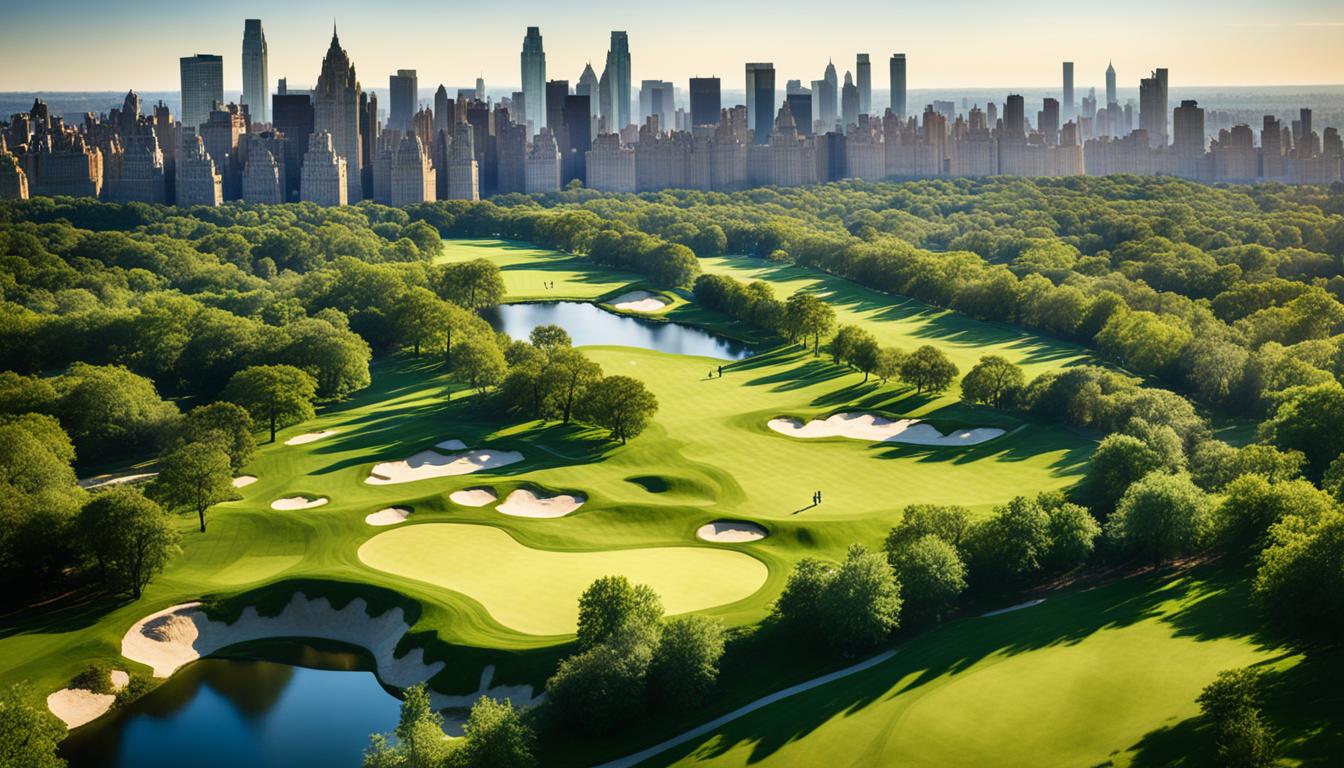Did you know that Central Park, a 843-acre oasis in New York City’s heart, welcomes 42 million visitors every year? This national historic landmark has been an important spot for recreation for both New Yorkers and tourists since its opening. But, the big question is: Does this vast green space include a golf course for golf enthusiasts?
Despite its vast size, Central Park does not feature a golf course. The city has consistently rejected proposals for one, choosing to preserve this iconic space for its millions of visitors. While golfing is not an option here, the park offers a variety of other activities that make it a standout destination in the Big Apple.
If you’re eager to play golf, don’t worry! New York City boasts plenty of golfing options nearby. Just a short distance away, you’ll discover excellent golf courses for all skill levels. These courses provide diverse challenges and amenities, similar to those found in other top golfing spots across the nation.
Key Takeaways
- Central Park covers 843 acres but does not have a golf course
- The park attracts 42 million visitors annually
- New York City has rejected proposals for golf courses in Central Park
- Nearby alternatives exist for golf enthusiasts
- Central Park prioritizes diverse recreational activities for all visitors
Table of Contents
- 1 Does Central Park Have a Golf Course?
- 2 The Truth About Golf in Central Park
- 3 New York City’s Stance on Golf in Central Park
- 4 The Controversial Golf Course Proposal
- 5 Central Park’s Current Recreational Offerings
- 6 Alternatives to Traditional Golf in Central Park
- 7 Alternative Golfing Options in New York City
- 8 The Challenges of Introducing Golf to Central Park
- 9 Preserving Central Park’s Historic Landscape
- 10 Golf Course Design Considerations for Urban Parks
- 11 The Economic Impact of Golf Courses in City Parks
- 12 Public Opinion on Golf in Central Park
- 13 The Future of Recreation in Central Park
- 14 Comparing Central Park to Other Urban Parks with Golf Courses
- 15 Exploring New York City’s Existing Golf Facilities
- 16 Environmental Implications of Golf Courses in Urban Areas
Does Central Park Have a Golf Course?
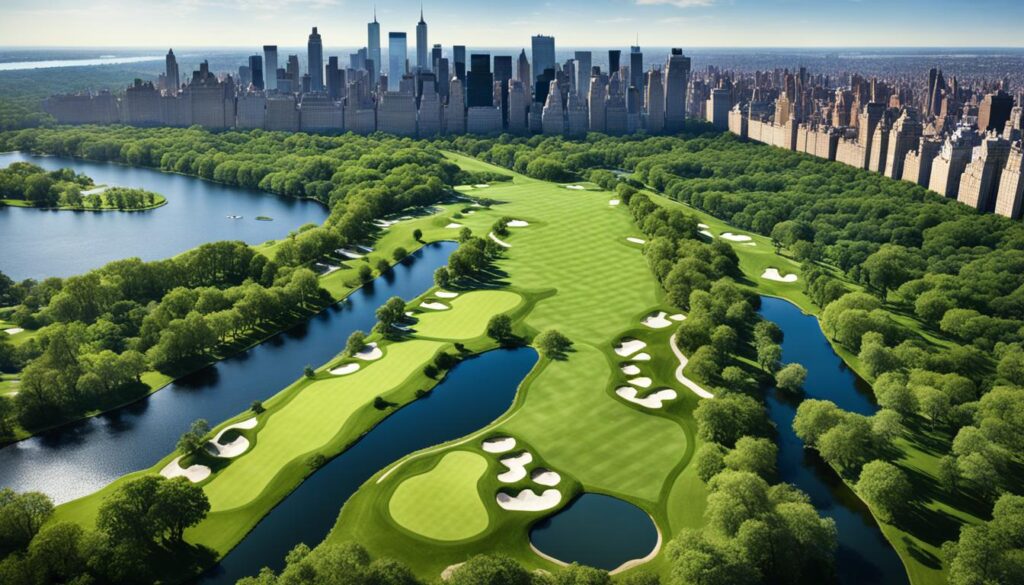
If you’re dreaming of teeing off in the heart of Manhattan, you might be disappointed. Central Park golf is not a reality. Despite its vast green spaces, NYC parks don’t include a golf course in this iconic location. Urban golfing enthusiasts will need to look elsewhere for their fix.
While Central Park doesn’t offer a real golf course, it did make a virtual appearance in Tiger Woods PGA Tour 2006. This fantasy course showcased 18 holes with stunning features:
- Four tee options ranging from 6,784 to 8,306 yards
- A challenging par 72 layout
- Hole 7: a monster 675-yard par 5 with multiple water hazards
- Hole 15: featuring a green on an island in the middle of a lake
For real-life urban golfing experiences, New York City offers 14 public golf courses spread across its boroughs. These courses provide various options for golfers of all skill levels. Here’s a glimpse at some NYC parks with actual golf facilities:
| Borough | Golf Course | Number of Holes |
|---|---|---|
| Bronx | Van Cortlandt Park Golf Course | 18 |
| Brooklyn | Dyker Beach Golf Course | 18 |
| Queens | Forest Park Golf Course | 18 |
| Staten Island | Silver Lake Golf Course | 18 |
While you can’t play golf in Central Park, you can enjoy numerous other activities in this beloved green space. From picnicking to boating, the park offers diverse recreational options for New Yorkers and visitors alike.
The Truth About Golf in Central Park
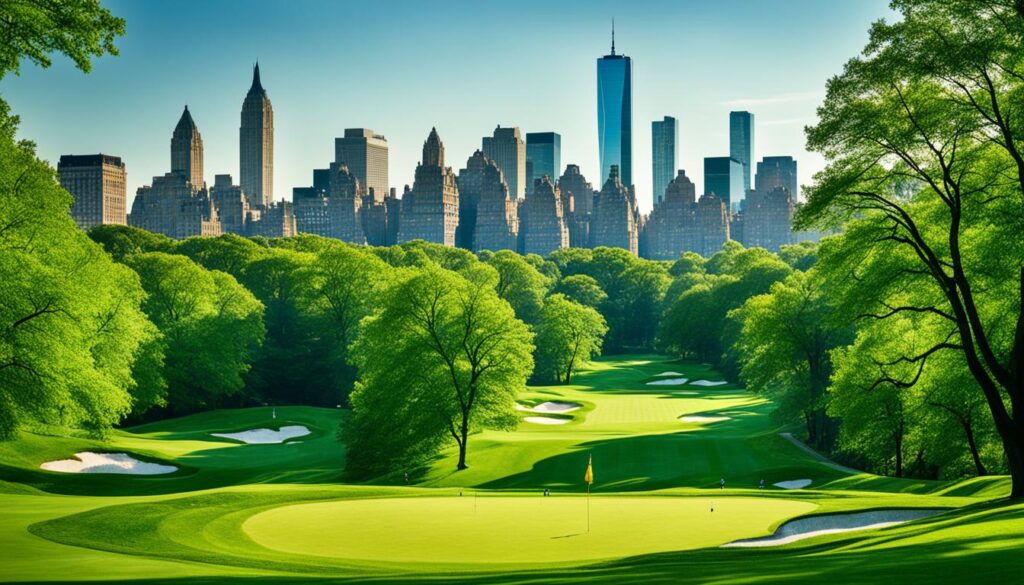
Central Park, a 843-acre gem in New York City’s heart, has seen numerous golf course proposals. Despite its vastness and the 42 million visitors it welcomes each year, it has never had a golf course. We will look at the facts about golf within this iconic urban sanctuary.
Historical Proposals for Golf Courses
Central Park’s history is dotted with golf course proposals. Yet, it didn’t follow suit with Van Cortlandt Park, which introduced the first public golf course in the U.S. in 1895. The park’s creators emphasized a variety of recreational pursuits and the preservation of its natural beauty.
Current Status of Golfing Activities
Currently, Central Park does not offer golfing. It prioritizes its existing attractions, appealing to a broad spectrum of interests. Visitors relish in activities like walking, sightseeing, and leisurely pursuits, especially during the summer peak.
Public Reaction to Golf Course Ideas
The public’s sentiment towards golf course proposals for Central Park is predominantly adverse. Both locals and tourists cherish the park’s current state. A report by the Central Park Conservancy indicates that 70% of visitors are locals, frequenting the park weekly. This deep connection shapes public opinion on potential transformations.
| Year | Visitor Count | Notable Information |
|---|---|---|
| 1973 | 12.3 million | Early visitor count data |
| 2009 | 25 million | 20% were tourists |
| 2016 | 42 million | Peak visitor numbers |
While golf enthusiasts may envision playing in Central Park, the focus remains on safeguarding its historic landscape and varied recreational activities. For now, golf enthusiasts can find alternative options across New York City’s five boroughs.
New York City’s Stance on Golf in Central Park
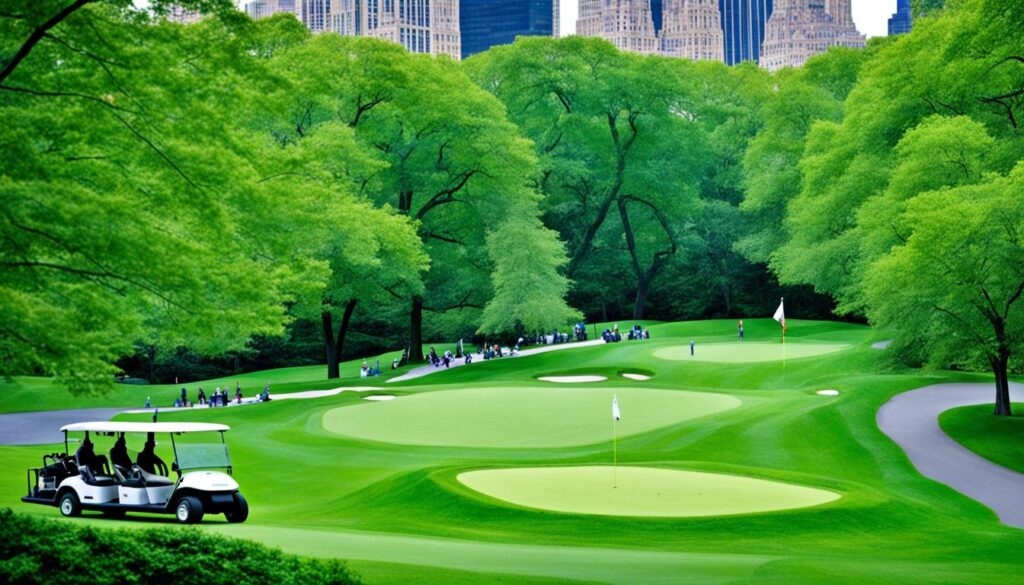
New York City’s parks policy has always put green space preservation first. It has rejected the idea of adding golf courses in Central Park. The city values maintaining the park’s historic beauty and making it accessible to everyone.
Despite some suggestions for golf courses, NYC has not considered them seriously. Central Park, a beloved green space, welcomes millions yearly without needing a golf course.
For those who love golf, New York City has many public courses beyond Central Park. Van Cortlandt Golf Course in the Bronx, established in 1895, was the first public course in the US. It hosted the nation’s first public golf tournament in 1896 and attracted about 2,000 golfers in 1899.
Other NYC golf options include:
- Forest Park Golf Links (Queens) – opened in 1901
- Mosholu Golf Course (Bronx) – opened in 1914
- Clearview Park and Golf Course (Queens) – founded in 1925
- South Shore Golf Course (Staten Island) – founded in 1930
These courses offer plenty of golfing spots. They help keep Central Park’s unique charm and green space for all New Yorkers to enjoy.
The Controversial Golf Course Proposal
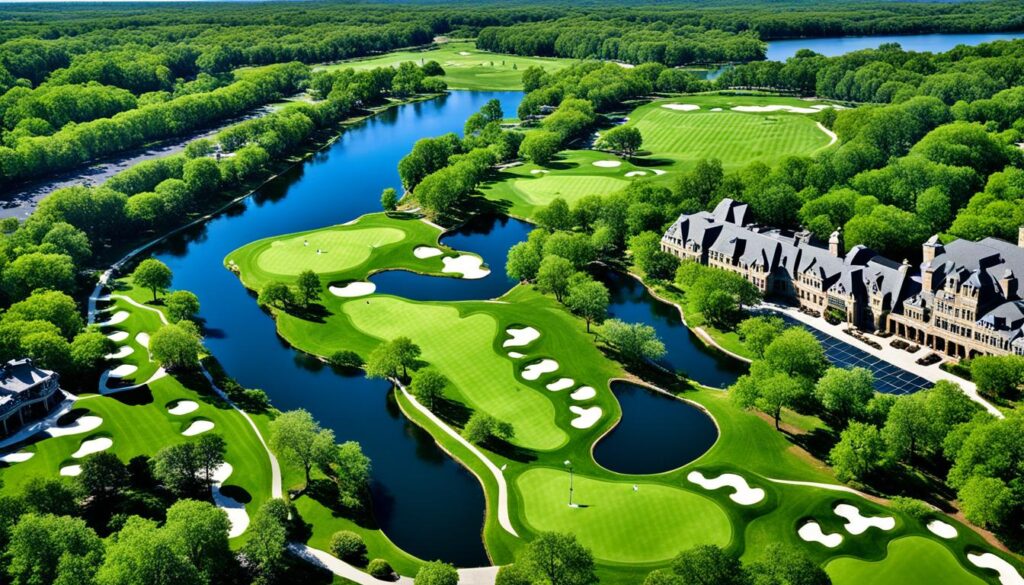
A bold proposal to add a golf course to Central Park ignited intense debate. It aimed to turn the New York City landmark into a golfing haven, testing the delicate balance between recreation and conservation.
The Cuomo and DeBlasio Course Concepts
Two 18-hole golf courses, named “The Cuomo” and “The DeBlasio,” were proposed. These plans aimed to weave golf into the park’s landscape. The greens fees were set between $50 and $200, varying by time of day and residency.
Proposed Layout and Design
A 36-hole layout was designed to enhance natural shot values while respecting existing roads and landmarks. The design aimed to harmonize with Central Park’s beauty, using water features and strategic bunkers.
Impact on Existing Park Features
The proposal drew fire for its potential harm to the park’s ecosystem and public areas. Critics contended that the golf courses would gobble up green space and upset wildlife habitats. A survey of 625 people showed a divided public, with worries about the $38 million price tag.
| Feature | Proposed Change | Public Concern |
|---|---|---|
| Open Space | Reduction by 155 acres | Loss of public recreation areas |
| Water Usage | Increase to 444 million gallons annually | Environmental impact |
| Wildlife Habitat | Disruption of 2-3 acres of wooded area | Displacement of local fauna |
City officials ultimately turned down the proposal. They prioritized preserving Central Park’s historic landscape and its role as a public space for all New Yorkers.
Central Park’s Current Recreational Offerings
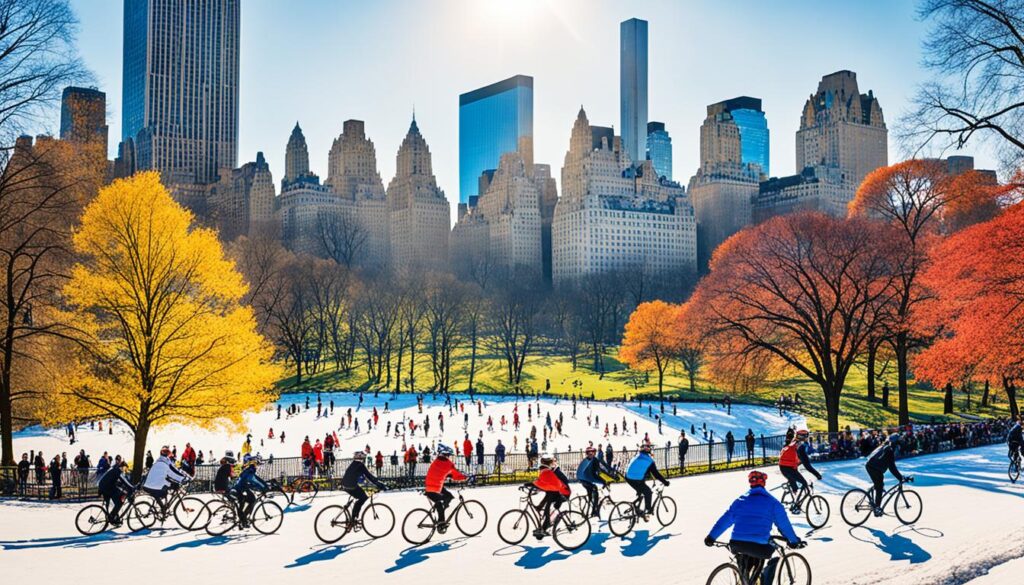
Central Park, a verdant sanctuary within New York City’s concrete jungle, presents a plethora of urban recreational activities. Though it lacks a traditional golf course, it is replete with activities for both visitors and locals.
NYC parks, particularly Central Park, are hubs for diverse recreational pursuits. Visitors can indulge in:
- Jogging and biking along scenic paths
- Rowing on the lake
- Picnicking in lush meadows
- Playing sports in designated areas
- Exploring nature trails
For golf aficionados in New York, there are numerous public golf courses nearby. These courses offer varied challenges and picturesque views, suitable for all skill levels and budgets.
| Activity | Location in Central Park | Season |
|---|---|---|
| Boating | The Lake | Spring – Fall |
| Ice Skating | Wollman Rink | Winter |
| Bird Watching | The Ramble | Year-round |
| Cycling | Park Drive | Year-round |
Central Park’s 843 acres are a vital space for urban recreation, offering a respite from city life. Whether you’re in search of tranquility or adventure, the park’s varied activities cater to all tastes. It remains a cherished spot for both New Yorkers and tourists alike.
Alternatives to Traditional Golf in Central Park
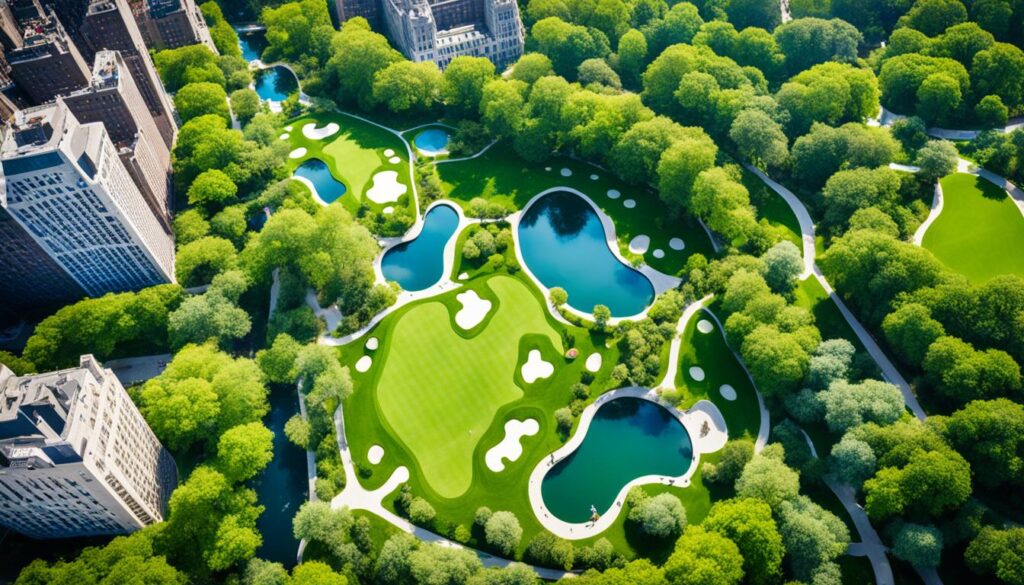
Central Park doesn’t have a traditional golf course, but it offers exciting alternatives for those who love urban recreation. These alternatives provide golf-like experiences without changing the park’s landscape.
Mini-golf Possibilities
A mini-golf course could be a great addition to Central Park’s attractions. It would offer a compact, family-friendly version of golf that complements the park’s existing recreational facilities.
Virtual Golf Experiences
Virtual golf simulators, like those at Five Iron Golf in Manhattan, could bring the golf experience to Central Park. These high-tech setups let you play famous courses worldwide without leaving the city.
Golf-inspired Fitness Activities
Golf-themed workout stations could be added to the park’s fitness areas. These would blend cardio exercises with golf-specific movements, appealing to fitness enthusiasts and golf lovers alike.
Frisbee Golf and Foot Golf
Frisbee golf and foot golf are gaining popularity as alternatives to traditional golf. These sports use the basic golf principles but replace clubs and balls with frisbees or soccer balls. They’re ideal for park settings.
| Activity | Equipment Needed | Skill Level | Estimated Cost |
|---|---|---|---|
| Mini-golf | Putter, golf ball | Beginner | $10-$15 per round |
| Virtual Golf | Simulator, clubs | All levels | $30-$50 per hour |
| Golf Fitness | Workout gear | All levels | Free with park admission |
| Frisbee Golf | Frisbee | Beginner to Intermediate | Free (bring your own frisbee) |
| Foot Golf | Soccer ball | Beginner to Intermediate | Free (bring your own ball) |
Alternative Golfing Options in New York City
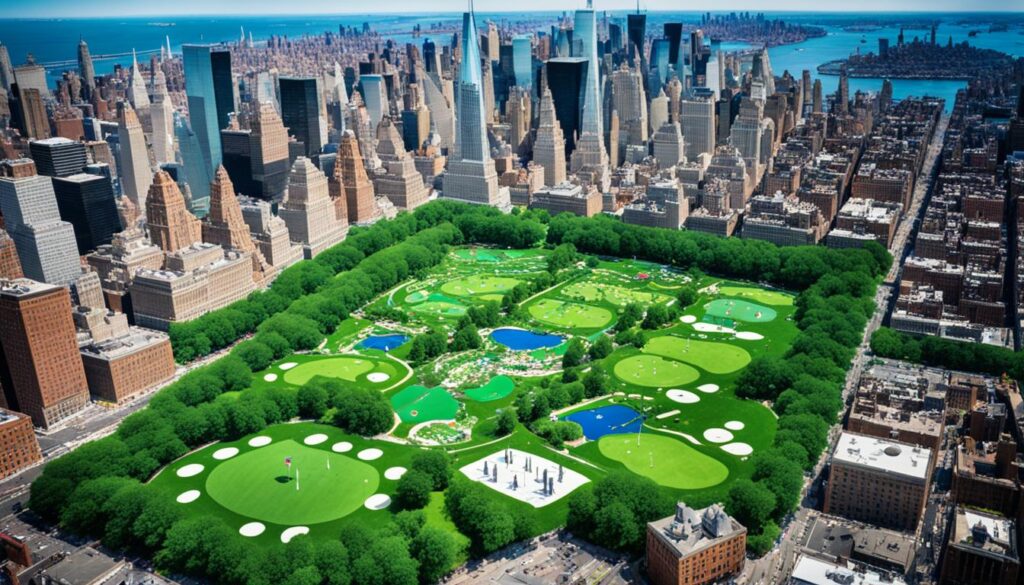
New York City is a haven for urban golfers, offering a variety of NYC golf courses. From public facilities to driving ranges, the city caters to golf enthusiasts with diverse options.
Public Golf Courses in the Five Boroughs
NYC is home to 14 public golf courses, each offering a unique experience. Van Cortlandt Golf Course in the Bronx stands out as America’s oldest public course. It has recently been renovated, featuring new greens and tee boxes. Dyker Beach Golf Course in Brooklyn provides a 6,438-yard green space for golfers to enjoy.
Driving Ranges and Miniature Golf Facilities
For those looking to practice or enjoy a family outing, NYC has several options. Randall’s Island Golf Center offers a large driving range. Brooklyn Greens provides youth instructional programs for kids aged 2-12. The Hack Shack features realistic simulators with up to 40 global courses.
Accessibility and Transportation to Nearby Courses
Many NYC golf courses are accessible via public transportation. For instance, Van Cortlandt Park is easily reached by subway. Skyway Golf Course in Jersey City, while not in NYC, offers stunning Manhattan views and is accessible by PATH train.
| Course | Location | Notable Features | Starting Rates |
|---|---|---|---|
| Van Cortlandt Golf Course | Bronx | Oldest public course, renovated | $53 (weekdays) |
| Dyker Beach Golf Course | Brooklyn | 6,438-yard course | $48 (weekdays) |
| Forest Park Golf Course | Queens | Tree-lined fairways, water holes | $50 (weekdays) |
| Douglaston Golf Course | Queens | Manhattan views | $21 (9-hole special) |
With these diverse options, NYC golfers can enjoy public golf experiences without leaving the city limits.
The Challenges of Introducing Golf to Central Park
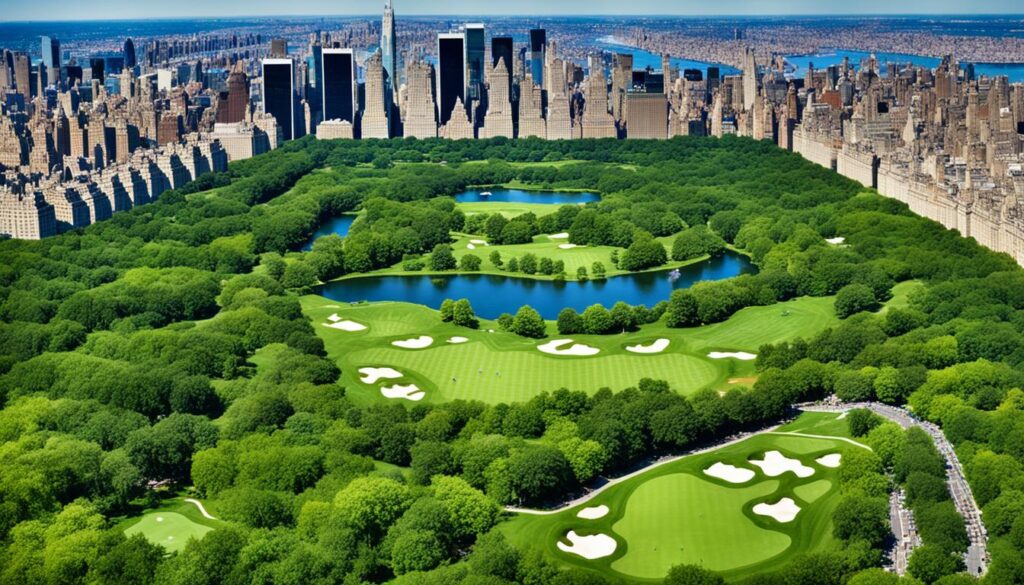
Introducing golf to Central Park encounters substantial hurdles in urban golf development. The park’s status as a national historic landmark makes any significant changes complicated. Managing public spaces effectively is essential when contemplating new recreational activities.
Park conservation efforts are at odds with the concept of a golf course. Central Park’s 843 acres already host a variety of activities. Adding golf could disrupt these existing uses and potentially damage the park’s ecological balance.
Public sentiment significantly influences decisions regarding parks. Many New Yorkers see Central Park as a refuge from the city’s hustle. A survey revealed that 85% of visitors feel a sense of tranquility in the park, unlike the city’s chaos. This perception makes the introduction of golf a challenging proposition.
Space constraints present another formidable challenge. A standard 18-hole golf course demands about 150 acres. Even a 9-hole course would occupy a substantial part of the park. This raises concerns about fairness in the allocation of public space.
| Challenge | Impact |
|---|---|
| Historic landmark status | Limits major changes |
| Ecological concerns | Potential harm to park’s ecosystem |
| Public opposition | 85% view park as sanctuary |
| Space requirements | 150 acres needed for 18 holes |
Despite the hurdles, alternatives like disc golf have thrived. Central Park’s 9-hole disc golf course provides an accessible option that doesn’t necessitate extensive landscape modifications. This example illustrates how innovative solutions can harmonize recreation and conservation in urban parks.
Preserving Central Park’s Historic Landscape
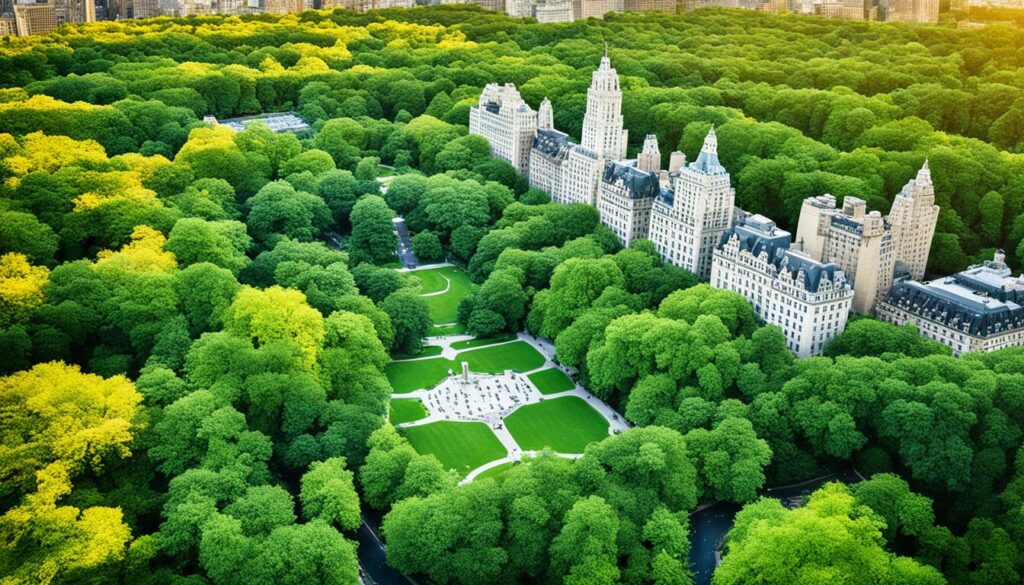
Central Park is a gem among NYC landmarks, blending recreation with historic preservation. This urban oasis, spanning 843 acres, is crucial for both New Yorkers and tourists. It serves as a sanctuary amidst the bustling city.
A National Historic Landmark
In 1963, Central Park was recognized as a national historic landmark. This honor highlights its pivotal role in American landscape design. The Central Park Conservancy ensures the park’s original beauty is preserved while catering to contemporary needs.
Recreation Meets Conservation
Central Park masterfully balances recreational activities with conservation efforts. It offers diverse activities, catering to those who prefer a serene experience or active pursuits. This dual approach ensures the park’s historic essence is maintained.
Significance to New Yorkers and Visitors
Every year, over 25 million people visit Central Park, seeking refuge from the urban chaos. It’s more than a recreational space; it’s a living museum of landscape architecture. Central Park is integral to New York’s cultural identity.
| Central Park Facts | Statistics |
|---|---|
| Annual Visitors | 25+ million |
| Conservancy Budget | $20 million |
| Funds Raised Since 1980 | $300+ million |
| Volunteer Hours (One Year) | 4,091 |
Central Park’s lasting allure is seen in its varied landscapes and activities. It caters to history enthusiasts, nature lovers, and fitness seekers alike. Central Park maintains its historic allure while offering something for everyone.
Golf Course Design Considerations for Urban Parks
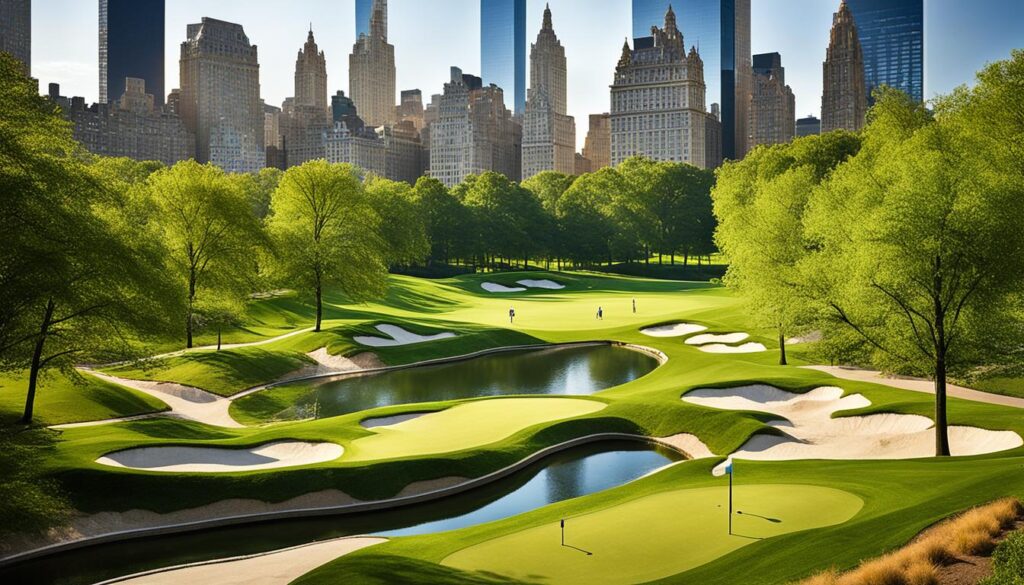
Urban golf course design faces unique challenges in park planning. Landscape architects must balance the needs of golfers with those of other park users. In dense city environments, space is at a premium, making traditional 18-hole courses impractical.
When considering golf for urban parks, designers often opt for smaller footprints. Mini-golf courses or 9-hole layouts can fit more easily into existing landscapes. These compact designs allow for creative use of limited space while preserving other park features.
Landscape architecture for urban golf courses prioritizes multi-use spaces. Fairways might double as open meadows when not in play. Putting greens could serve as picnic areas during off-hours. This approach maximizes park utility for all visitors.
Environmental impact is an important factor in urban golf course design. Sustainable practices like native plantings and water conservation are essential. These eco-friendly methods align with broader park planning goals and public expectations.
| Design Element | Urban Consideration |
|---|---|
| Course Layout | Compact, multi-use design |
| Vegetation | Native, low-maintenance plants |
| Water Usage | Efficient irrigation systems |
| Accessibility | Integration with existing paths |
Successful urban golf course design requires collaboration between golf architects, city planners, and community members. This ensures the course meets both recreational needs and urban planning standards.
The Economic Impact of Golf Courses in City Parks
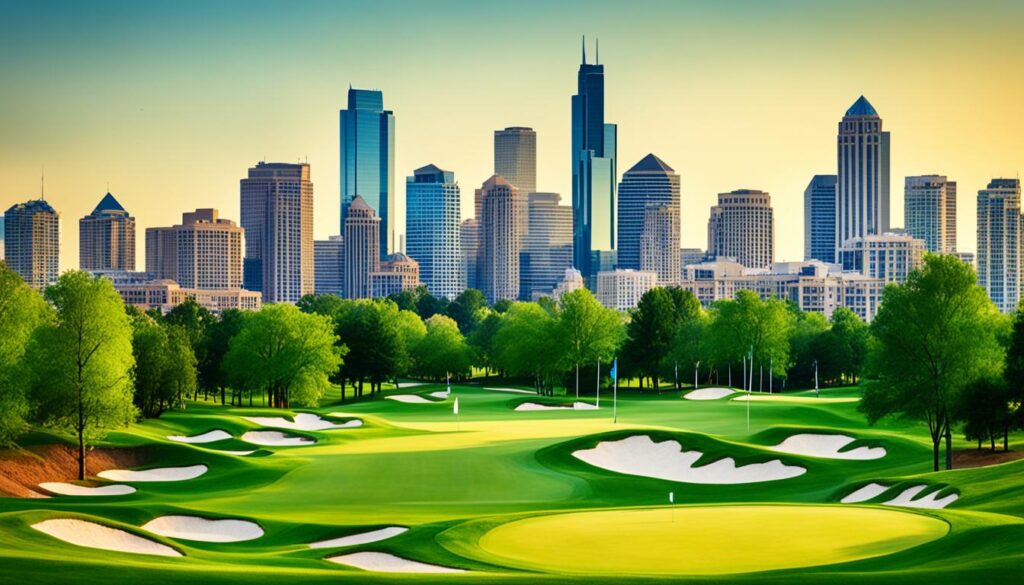
Golf courses in urban parks have a profound effect on local economies. In New York, outdoor recreation activities generated $21.1 billion in economic activity in 2020. This figure supported over 241,000 jobs, with golf being a significant part of that, under the 18% allocation for outdoor events and sports facilities.
Potential Revenue Generation
Urban golf economics reveal substantial potential for revenue. A study in Wisconsin and Minnesota found that golfers spent between $251 to $352 per trip. If applied to New York City, this could significantly boost revenue for park upkeep and local businesses.
Maintenance Costs and Environmental Concerns
Maintaining golf courses in parks is costly. These courses in NYC alone have a carbon footprint ranging from 2.6 to 15 million kg CO2e annually. The use of fertilizers also leads to significant nitrogen and phosphorus leaching, posing environmental risks.
Effect on Surrounding Property Values
Golf courses can affect property values nearby. While they may boost some property values, they can also decrease others. This effect depends on the location and accessibility. In densely populated areas like Manhattan, the debate over converting park space to golf courses remains contentious.
| Factor | Impact |
|---|---|
| Revenue Generation | $250-$350 per golfer trip |
| Carbon Footprint | 2.6-15 million kg CO2e annually |
| Nitrogen Leaching | 3,035-176,500 kg annually |
| Phosphorus Leaching | 607-35,300 kg annually |
Public Opinion on Golf in Central Park
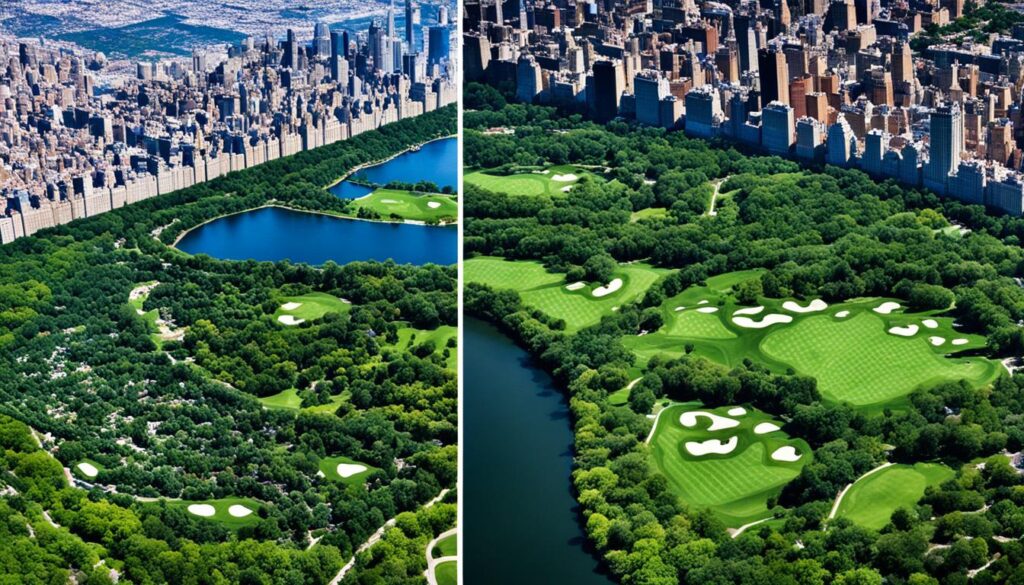
The debate over introducing golf to Central Park has ignited fervent discussions among New Yorkers. A significant portion of NYC public opinion is against the idea of adding a golf course to this revered urban sanctuary. Many see the value in preserving the park’s current mix of recreational activities and its historical essence.
Urban recreation preferences in New York City tend towards maintaining the park’s current state. The notion of a golf course in Central Park has garnered substantial opposition, with notable figures like former Mayor Michael Bloomberg voicing their disapproval.
To gauge public sentiment, We will look at some crucial statistics:
| Aspect | Central Park (Potential) | Urban Golf Courses (Example) |
|---|---|---|
| Size | 843 acres | 700+ acres |
| Visitors per acre annually | Unknown | 1,200 (Presidio Golf Course, SF) |
| Nearby park visitors per acre annually | Current usage | 24,000 (Golden Gate Park, SF) |
These statistics underscore the potential for underutilization of urban golf spaces versus multi-use parks. Given golf’s waning popularity and the financial woes of many public courses, it appears that New Yorkers favor keeping Central Park as a versatile space for all.
The Future of Recreation in Central Park
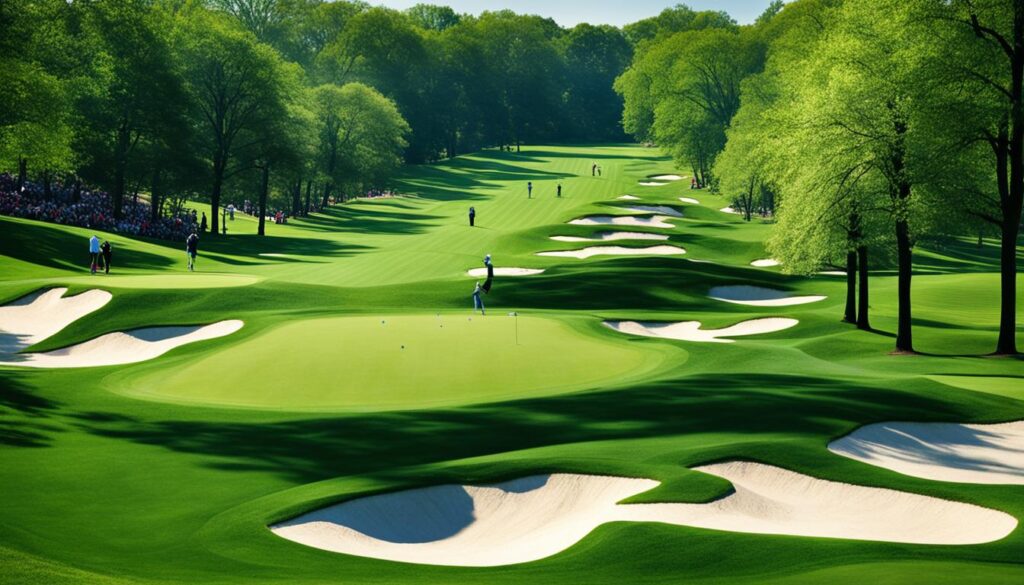
Central Park’s future is set to shine as NYC’s green spaces adapt to new recreational trends. This iconic urban park is poised to integrate innovative activities while maintaining its historical allure. It stands as a cornerstone of urban park development.
Soon, Central Park will introduce bee colonies, enhancing the park’s biodiversity and educating visitors about pollinators’ crucial role. This move underscores the growing emphasis on environmental conservation within urban landscapes.
Expect an uptick in nature-focused activities within the park. Birdwatching and wildflower appreciation are becoming increasingly popular, appealing to a broad audience. These pursuits enhance the park’s natural allure while catering to diverse interests.
Central Park is grappling with how to meet the needs of all its visitors. Some advocate for expanded trails and bike paths, while others, especially seniors and dog owners, raise safety concerns. Finding a harmonious solution for all will be a pivotal challenge in future planning.
| Current Activities | Future Additions |
|---|---|
| Walking trails | Bee colony education |
| Birdwatching | Enhanced wildflower areas |
| Dog walking | Accessibility improvements |
As urban park development advances, Central Park remains dedicated to offering a wide array of recreational activities while safeguarding its natural essence. Its future likely includes a mix of traditional and cutting-edge programs, ensuring it remains a cherished green space in NYC for future generations.
Comparing Central Park to Other Urban Parks with Golf Courses

Central Park is a standout in urban park comparisons, thanks to its unique approach to recreation. It has kept its original design, eschewing golf courses for a variety of activities. This reflects New York’s dedication to maintaining open spaces for all.
Golf is common in city parks, but Central Park offers a distinct experience. Instead of golf, it features natural landscapes that highlight its historic beauty. This approach has cemented Central Park as a cherished retreat in Manhattan.
| Park | Location | Golf Course | Unique Features |
|---|---|---|---|
| Central Park | New York City, USA | None | The Ramble, Ravine, lakes, ponds |
| Lincoln Park | Chicago, USA | 9-hole course | Beaches, nature preserves, wildlife |
| Hyde Park | London, UK | Pitch and putt course | Serpentine Lake, Kensington Gardens |
| Ueno Park | Tokyo, Japan | None | Museums, zoo, cherry blossoms |
Central Park stands out by focusing on a diverse range of activities, unlike parks with golf. A poll revealed that 48.81% of respondents preferred Central Park over others with golf. This shows the park’s success in balancing recreation and conservation. It offers a true escape from the city’s hustle and bustle.
Exploring New York City’s Existing Golf Facilities

New York City is a haven for golfers, with twelve 18-hole public golf facilities across its boroughs. These courses cater to all skill levels, offering a diverse range of experiences. From historic to modern, golfers can find something to suit their preferences.
The Van Cortlandt Golf Course in the Bronx is a landmark, being America’s first public course since 1895. Queens boasts four courses, including Clearview Park and Forest Park. Staten Island is home to La Tourette, a course with a historic 1870 clubhouse.
Over the last two decades, NYC’s public golf facilities have undergone substantial upgrades. Improvements in course conditions, management, and amenities have enhanced the overall experience. Despite challenges like congestion and limited tee times, these courses offer unique features. Golfers can enjoy city landmark views and diverse dining options after their rounds.
| Borough | Notable Courses | Unique Features |
|---|---|---|
| Bronx | Van Cortlandt, Pelham Bay & Split Rock | First public course, 36-hole complex |
| Brooklyn | Dyker Beach | Once one of the world’s busiest courses |
| Queens | Clearview Park, Forest Park, Kissena, Douglaston | Four diverse course options |
| Staten Island | La Tourette, Silver Lake, South Shore | Historic clubhouse, prestigious design |
NYC’s public golf courses see around 600,000 rounds played each year. They attract both locals and visitors, offering accessible and affordable golfing in the city’s heart.
Environmental Implications of Golf Courses in Urban Areas
Urban golf sustainability is a critical topic in green space management. Golf courses in cities present both benefits and challenges for the environment. They offer valuable green spaces amidst concrete, serving as sanctuaries for wildlife and native plants. These areas also protect water resources and can revitalize degraded landscapes.
Water management is essential for urban golf courses. Implementing smart watering systems and utilizing treated wastewater (effluent) conserves this vital resource. Turfgrass acts as a natural filter, purifying water before it flows back into lakes and streams. However, high salinity in effluent water can complicate course maintenance.
The environmental footprint of urban golf courses goes beyond water issues. These spaces significantly cool urban areas, according to a Minnesota study of 135 courses. They support more pollinators than residential or industrial zones. Golf destinations like Orlando demonstrate how courses can adapt to local climates and incorporate native plants, balancing recreation with conservation.
Initiatives such as the Audubon Cooperative Sanctuary Program for Golf Courses encourage environmentally responsible practices. These programs focus on wildlife management, reducing chemical use, and conserving water. As cities expand, golf courses play a vital role in urban ecosystems. They provide a unique chance to preserve biodiversity and offer essential ecosystem services in our rapidly urbanizing world.
